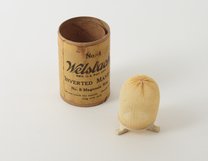No. 4 Inverted Mantle with No. 8 Magnesia Ring
- 1890 – 1930

Rights
 BY 4.0
BY 4.0Download all 6 images
PDFZIPof full-sized JPGsDownload selected image
Small JPG1200 x 1200px — 97.5 KBLarge JPG2880 x 2880px — 495 KBFull-sized JPG4000 x 4000px — 887 KBOriginal fileTIFF — 4000 x 4000px — 45.9 MB
 This work is licensed under a Creative Commons Attribution 4.0 International License.
This work is licensed under a Creative Commons Attribution 4.0 International License.Unused Welsbach No. 4 Inverted Mantle and No. 8 Magnesia Ring in its original cardboard box from Lindsay Light and Chemical Company.
The Welsbach gas mantle is a device made of fibers impregnated with oxides of cerium and thorium, an element that is mildly radioactive. Mantles produce a bright white light when heated with a gas flame; effectively the gaslight equivalent of a filament in an electric lightbulb. Invented in the 1880s by Austrian scientist Carl Auer Von Welsbach (1858-1929), gas mantles were used extensively in street lighting and in gas-powered appliances. The Welsbach gas mantle was the first industrial product to make use of rare earth elements. Welsbach mantels were sewn and then packed into cardboard tubes for shipping and sales. The Lindsay Chemical Company in Chicago took over the Welsbach marketing logo in the early twentieth century and continued the production of mantels compatible with Welsbach products until the mid-1930s.
| Property | Value |
|---|---|
| Creator of work | |
| Contributor | |
| Place of manufacture | |
| Format | |
| Genre | |
| Medium | |
| Extent |
|
| Language | |
| Subject | |
| Rights | Creative Commons Attribution 4.0 International License |
| Credit line |
|
Institutional location
| Department | |
|---|---|
| Physical container |
|
Related Items
Cite as
Science History Institute. No. 4 Inverted Mantle with No. 8 Magnesia Ring. Photograph, 2021. Science History Institute. Philadelphia. https://digital.sciencehistory.org/works/of2d967.
This citation is automatically generated and may contain errors.

Rights
 BY 4.0
BY 4.0Download selected image
Small JPG1200 x 930px — 75.1 KBFull-sized JPG2782 x 2156px — 335 KBOriginal fileTIFF — 2782 x 2156px — 17.2 MB
Rights
 BY 4.0
BY 4.0







